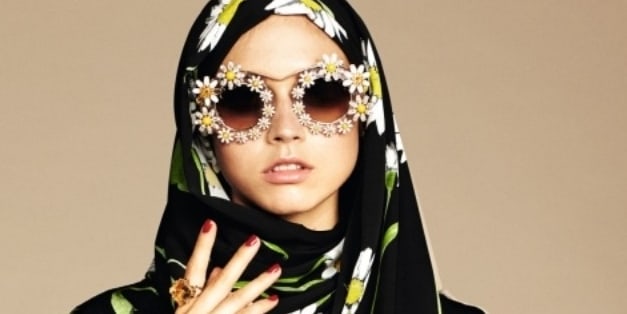
Italienska lyxmärket i stor satsning på hijabmode
Det italienska lyxmärket Dolce & Gabbana lanserar sin första hijab- och abayakollektion. Forbes beskriver det som modehusets ”smartaste drag på åratal” och konstaterar att kvinnor i de oljerika länderna i Mellanöstern ofta kombinerar luxuösa märkeshandväskor och skor med mer traditionella abaya-plagg, en dräkt som täcker kroppen men inte ansiktet.
Plagg från Dolce & Gabbana, skriver tidskriften, är i privata sammanhang också mycket populära bland många kvinnor som i offentligheten bär mer täckande kläder.
Forbes pekar också på att försäljningen av lyxprodukter i Mellanöstern stigit från 6,8 miljarder dollar 2014 till 8,7 miljarder dollar 2015.
bakgrund
Abaya
Wikipedia (en)
The abaya "cloak" (colloquially and more commonly, Arabic: عباية ʿabāyah , especially in Literary Arabic: عباءة ʿabāʾah ; plural عبايات ʿabāyāt , عباءات ʿabāʾāt ), sometimes also called an aba, is a simple, loose over-garment, essentially a robe-like dress, worn by some women in parts of the Muslim world including in North Africa and the Arabian Peninsula. Traditional abayat are black and may be either a large square of fabric draped from the shoulders or head or a long caftan. The abaya covers the whole body except the face, feet, and hands. It can be worn with the niqāb, a face veil covering all but the eyes. Some women also wear long black gloves, so their hands are covered as well.
The Indonesian and Malaysian women's traditional dress kebaya gets its name from the abaya.
bakgrund
Hijab
Wikipedia (en)
A hijab or ḥijāb (/hɪˈdʒɑːb/, /hɪˈdʒæb/, /ˈhɪ.dʒæb/ or /hɛˈdʒɑːb/; Arabic: حجاب, pronounced [ħiˈdʒæːb] or [ħiˈɡæːb]) is a veil that covers the head and chest, which is particularly worn by some Muslim woman beyond the age of puberty in the presence of adult males outside of their immediate family and, according to some interpretations, in the presence of adult non-Muslim females outside of their immediate family. It can further refer to any head, face, or body covering worn by Muslim women that conforms to a certain standard of modesty. Hijab can also be used to refer to the seclusion of women from men in the public sphere, or it may embody a metaphysical dimension – Al-hijab refers to "the veil which separates man or the world from God". In fact the word "veil" derives from a Latin word which means much the same as hijab. This vision of the world was already expressed in pre-islamic cultures like Classical Rome where the Emperor Augustus encouraged his citizens all around the Mediterranean to enter temples "capo velato" literally "with their heads veiled", by which he intended clothing that did not differ much from traditional Saudi clothing for men and women today. Augustus himself appeared like this in propaganda pictures and temple portraits (see the Ara Pacis temple in Rome). The Romans made part of a greater set of Mediterranean/Middle Eastern cultures with roots in Mesopotamia(Iraq) and Egypt and they transmitted this legacy to both the eastern and western parts of the Roman Empire, which today constitute approximately the Muslim Mediterranean (and parts of the Middle East) and Europe. The common roots of this legacy may be noted. Christian women can still today choose to express their piety and modesty by "taking the veil" and joining a religious order, and often dress in what Muslims call a chador.
Most often, it is worn by Muslim women as a symbol of modesty, privacy and morality. According to the Encyclopedia of Islam and Muslim World, modesty in the Quran concerns both men's and women's "gaze, gait, garments, and genitalia." The Quran admonishes Muslim women to dress modestly and cover their breasts and genitals. Most Islamic legal systems define this type of modest dressing as covering everything except the face and hands in public. These guidelines (for covering of the entire body except for the hands, the feet and the face) are found in texts of fiqh and hadith developed after the revelation of the Quran but, according to some, are derived from the hijab ayahs in Quran. Many believe Qur'an does not mandate Hijab.
The term hijab in Arabic literally means “a screen or curtain” and is used in the Quran to refer to a partition. The Quran tells the male believers (Muslims) to talk to the wives of Muhammad behind a curtain. This curtain was the responsibility of the men and not the wives of Muhammad. This leads some to claim that the mandate of the Quran to wear hijab applies to the wives of Muhammad, not women generally. Αlthough hijab is often seen by critics as a tool utilized by men to control and silence women, the practice is understood differently in different contexts.
Omni är politiskt obundna och oberoende. Vi strävar efter att ge fler perspektiv på nyheterna. Har du frågor eller synpunkter kring vår rapportering? Kontakta redaktionen